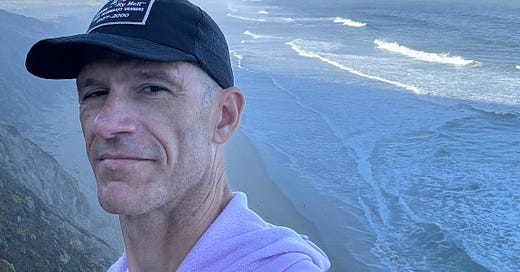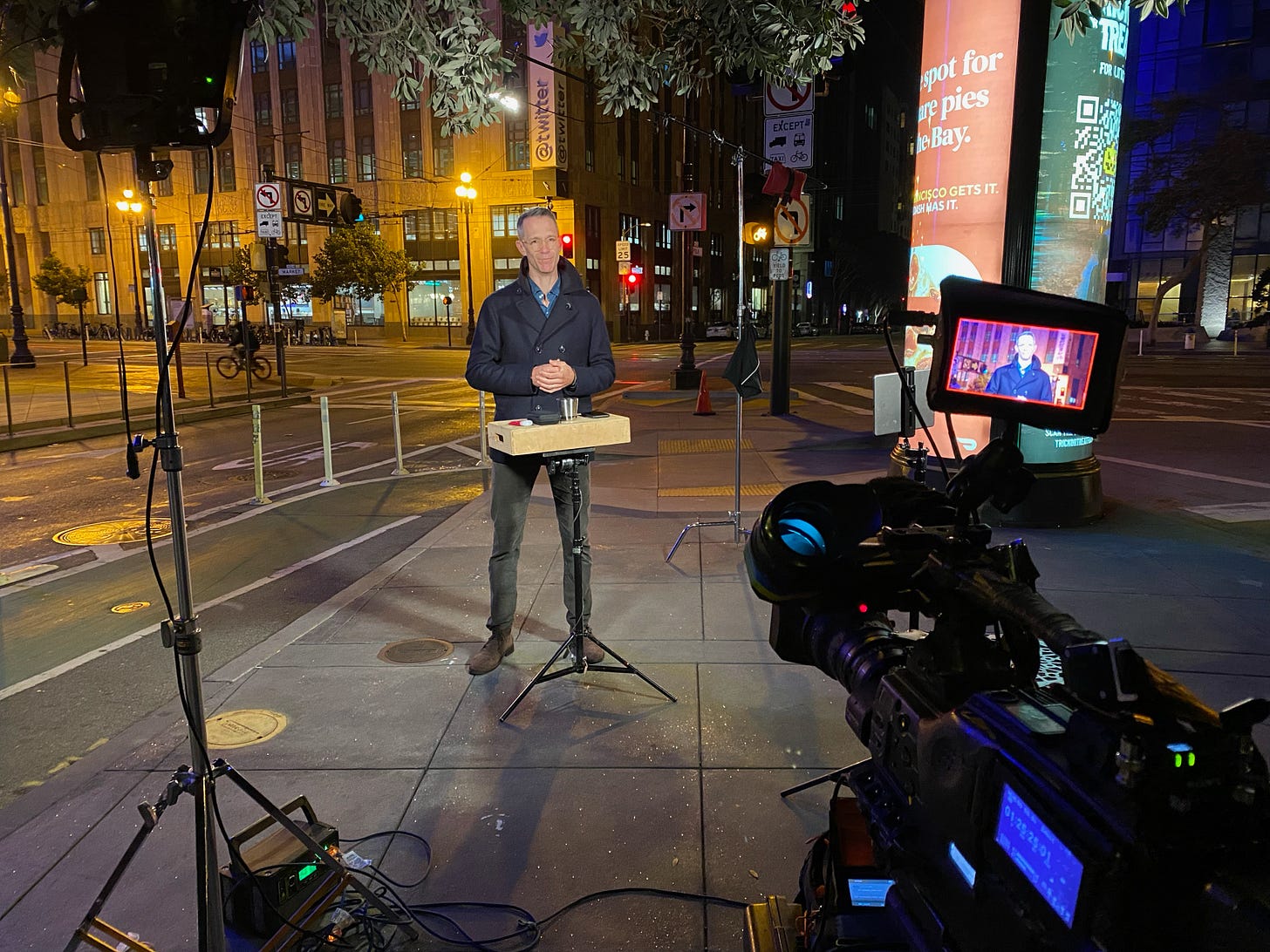Welcome to The Rip Current
There's a powerful flow of money, technology, beauty, and human weirdness that pulls on all of us. But you don't have to exhaust yourself paddling against the tide. You can learn to spot The Rip.
I’m writing you from my home in Oakland, California, on one of the few days of the year when it’s truly too dangerous to go into the ocean.
For the past eight months, since I parted ways with NBC News, I’ve been finding solace and dopamine through surfing. This isn’t the first time I’ve retreated into the ocean after professional upheaval. In my 20s, when I was reporting on the first Internet boom (this, children, is when Amazon sold only books), I left a job at The Industry Standard in a similar frame of mind: worried that the world was falling too hard, too fast, for a technology that was clearly going to transform how we did business, understood reality, and even thought. I immediately went out and bought a board and a wetsuit, and threw myself into learning to ride waves out at the edge of San Francisco.
This year has been the same thing all over again. Back in 2022 I released my first book, The Loop: How AI is Creating a World without Choices and How to Fight Back, in which I argue that AI creates a mania in the human mind that we are uniquely ill-equipped to resist. In The Loop I made the case that we should be restrained and thoughtful before we hand the world to a package of unproven but intoxicating technology, and specifically describes all the reasons our brains are going to fall in love with AI before we know what it can and cannot do.
But hey, weird, it didn’t work. ChatGPT came out nine months later, the first of an avalanche of AI products, and people dutifully handed politics, content moderation, recipes, and wedding vows right over to them. Then budget cuts arrived at NBC News, I was out of a job, the world was sliding away from me, and I went right out for a new board and wetsuit.
I was physically stronger back when I first did this in my 20s, but I’m a much braver and more resourceful person now, and because of that — and 20 years of talking to people for a living — I was quickly able to strike up conversations and gather some intelligence. It’s a weird society, surfing. The socializing mostly happens beforehand, in a waterfront parking lot, shivering in the fog and squinting out at the conditions in silence together before each of us dons a wetsuit out of the back of our car. Sometimes surfers just want to be left alone, and resent any new arrivals who might steal a wave and ruin the break. But in general I find that people want to share their expertise. And here in Northern California, where the water is like an electric shock to your hands and gives you an ice cream headache the first time you duck under a wave, and where anyone you speak with is happy to tell you about the time a Great White has loomed out of the darkness and slid by, 20 feet of ancient predator I hope I never encounter — well, anyone crazy enough to get into the water here is offered a certain collegiality.
I’ve learned an enormous amount in these conversations: if you line up that farmhouse and this beach umbrella, you’ll be in the perfect takeoff spot for a breaking wave; that waiting here over this sandbar isn’t as reliable or as fun as paddling out over that rock reef. But one of the most valuable and deeply appreciated pieces of information any surfer can share with another, the one that can transform an hour of exhaustion and real danger into a sun-blinded three hours of out-of-your-mind fun, is the location of the rip.
A rip current is the place where waves that arrive on a beach slide off and drain back out with such consistency that they’ve typically hollowed out an underwater trough, one that pulls liquid outward in a constant, hidden river. The rip, as any lifeguard or teenage shredder calls it, can be incredibly dangerous. While surfing once during the pandemic I encountered a man caught in a rip, exhausted after paddling against it, shouting pleas at the sky. (When I brought him to shore on my board, a lifeguard sprinted from his truck toward me — I thought he was coming to shake my hand — and then shot right past me, to grab a young girl who’d been swept away. That guard pulled people out of the rip all day.) And surfers aren’t immune — at Ocean Beach, San Francisco’s largest city break, a rip current wide as a football field can form, carrying idiots like me almost a mile out to sea.
The rip can be hard to spot. Lifeguards are trained to know the telltale signs, but I often have trouble seeing the strange crenelations that form where water is being sucked out even as waves continue to travel toward land. They’re the product of vast, complicated forces: energy that began in a storm thousands of miles out to sea, rock crushed into powdery sand millions of years ago, the pull and release of the ocean by our moon’s gravity during high and low tides. I’m trying to get better at it.
But it’s not all danger and death. The rip current at some beaches is, in fact, a gift to surfers. Plowing a 7-foot length of fiberglass and styrofoam through endless whitewater can often exhaust you long before you get a chance to even reach the break. But in some places, the rip is your express ride to fun. At one break south of San Francisco, a tattooed, gold-grilled dude who I’d assumed would brush me off instead walked me to the shore to gleefully explain that if I entered the water right at the base of the southern cliff, the rip would carry me directly to the spot I wanted. Sure enough, the conveyor belt he promised was there. It shot me out past a worrisome series of dangerous-looking rocks, and deposited me right at the base of the first waves of my day.
I’m naming my newsletter, the one you’re reading, after this intimidating feature of the shoreline because I think we’re all caught in the rip right now.
Billionaires are on a rising tide. They pay nothing in taxes, they wield enormous political power without ever earning a vote, they make scarring decisions about everything from how we communicate with our families to how many satellites we see in the night sky. Many among this tiny group of people rose to power through habits and traits that make them entirely incapable of relating to the rest of us, and in some cases intolerant to the point of outright hostility.
Men — especially young men — are adrift in an online world that sorts them by and amplifies their loneliness, their anger, and their most asocial desires, even as the real world becomes more and more unpalatable and disappointing by comparison. And this unpeeled condition they’re in makes them the perfect target market for grifters of every stripe, from racist commentators to the companies that make custom-tailored AI girlfriends available at a dollar a minute.
We cling to a mythology of American individualism and gut-decisionmaking even as it becomes clear that surviving rising seas and deepening division will require intense communal effort and complex calculation. And our cultural self-image doesn’t help. After all, companies would far rather sell products to Han Solo, who doesn’t want to hear about the odds, than to C3PO, who knows the odds backwards and forwards.
I’m calling this new journalistic effort The Rip Current because I think these sorts of forces are hard to spot when you’re in their grip, and right now we’re being washed right out to sea. At many of the outlets I’ve worked over the past 25 years, the first question an assigning editor will ask after you’ve pitched a story is “why now?” The accepted wisdom is that a story must directly connect to a news event. But I’m going to be softening my standards around that one; the journalistic moment we’re in allows me the editorial freedom to stand back from the news cycle, and the problems we face aren’t going to be properly explored one news item at a time.
I’m going to be ranging across topics. My beat for most of my professional life has been technology. But tech has metastasized into every other beat, and before long I found myself covering more or less everything. Professional sports are now betting their future on you and me being able to gamble on our phones. The greatest anxieties of national security experts lie in the possibility of a Chinese attack on Taiwan, which supplies the semiconductor brains of our every modern convenience. AI is creating such demand for electrical power that the US is poised to reverse forty years of policy and restart nuclear power plants.
I can’t tell you exactly what The Rip Current will cover. Honestly, I don’t know. I’m going to start with my core interests — greed, beauty, and human weirdness — and see what sticks. I’m going to listen to your feedback, and hopefully learn as much from you as you get out of me. And I’m going to be creating a parallel YouTube channel connected to what I do here that will hopefully give you a separate but satisfying way to experience these topics. The traditional business model of journalism is in freefall, so these are the best possible avenues for continuing to do what I do. (And if you feel so inclined, a paid subscription will get you even more great content.) I’m grateful to you for being here with me, and I’m eager to hear what you think. Thank you.






In this day and age, so much has been made about the brilliance of those “innovating” or “disrupting” but in you, I’ve always found brilliance in the truest sense of the word. You are a luminary in the way we need most right now. From The Loop, to every report I’ve seen you file, your insight, wisdom and caution has been a true north. So grateful to be able to read your thoughts here! Looking forward to making Rip Current my first read of the day. 🤙
This is so exciting!!! Huge congratulations on the launch I can’t wait to read